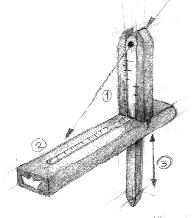Fongateihains
(The Timing Device)
These wheels, made of stone, had a large hole in the middle and around the hole, the stone was segmented in up to twelve parts, each representing a part of the day (for unknown reasons, the Giants had their days separated in twelve parts). What was obvious, was that the sun, Fon, made a way over the sky each day, and the day starts when Fon climbs over the horizon, and end when it falls over it, to rise again the next day.
But to know how late it is, one should consider the place in the sky where Fon reaches its daily limit (where it can climb no higher), where it rises, where it falls. It was also noticed, Fon rose higher in summer than in winter. These two irregularities where the hardest to beat by Dalethian scientists.
Now, they’ve made a system with large, standing Fongateihains, and smaller, adjustable portable ones. The large Fongateihains are used to tell the date and to make sure the portable ones are adjusted in the right way.
The portable Fongateihains comes in many different designs, from simple sticks to beautifully decorated golden ones. The technical design is very simple:
- The upward stick is adjusted for the date. Say, it is Gräinsday, then the vertical stick should be put in the Gräinsday position. Those who don’t know what day it is should check a standing Fongateihains.
- Now, makes it so that the light of Fon falls exactly through the hole in the vertical stick. The horizontal stick should be held very horizontal (a small reservoir with water and a air bubble will do the trick to adjust this in the right way). The shadow of the vertical stick should fall on the horizontal stick.
- Where the light from the hole falls on the horizontal stick, there is a mark. This shows the time of day. One should be aware of it being morning or not...
 |
A picture of the Fongateihains:
|
Wait until Fon reaches its highest point. Then use the Fongateihains, with the vertical stick in the “Date” marked position. The light of Fon will fall on the horizontal stick, where marks for the right date are made. This way it is possible to adjust the vertical stick for the right date, and use the Fongateihains for the stondes in the next days.
A third way to use it is when the date and time are known, to tell the place. This is much more difficult and used seldom. There are some maps with the date/time rate on it to use for this purpose.
For corrections of the zone one is in, special adjustments should be made at the local Fongateihains. The instrument can be bought in many places for those places, but except for those with the Imperial Crown on it, the quality can be bad, and the instructions will be even worse...
The Dalethians have designed a clock too, but that didn’t work: all stondes were the same length in summer and winter and the clock couldn’t tell when the sun would rise. They have left the experiment disappointed and focused on the development of the Fongateihains.
The current ideas of development lay in the direction of a Fongateihains that works in the dark (night, inside, etc.) as well. The first prototype has already been made: it was a regular Fongateihains with a lamp on it. The developer was sacked from the research team.
Related topics: